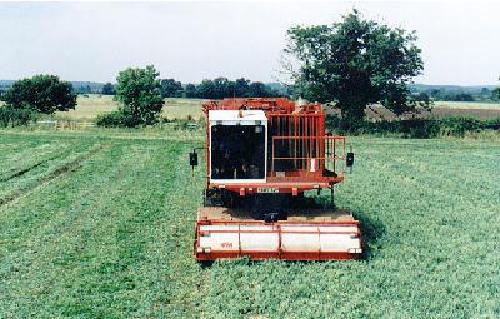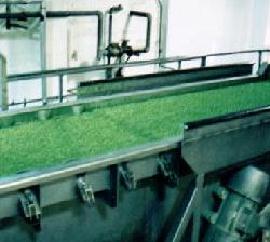|

The nation's favourite green vegetable is probably peas but apart from a few weeks in summer, we rarely buy them from the greengrocer's shop in the pod straight from the field. Instead, they come shelled and frozen yet just as fresh and succulent as though they had just been plucked from the vine. The reason is that frozen peas are now big business geared to the requirements of the convenience food industry. Growing them is part of a major co-ordinated programme involving farmer and processor. The peas are picked at the very moment they reach their prime and are preserved, by freezing for the consumer shopper, within 2½ hours. Indeed, large growing and freezing companies take over the whole operation. Grower groups supply the seed, dictating the times of planting and carrying out the harvest with specialised viners after which the crop is frozen, canned or freeze-dried.
Peas (Pisum sativum) are a leguminous crop similar to beans and they have a low, trailing habit of growth. The compound leaves end in a series of tendrils which entwine themselves around nearby plants and help support the weak stem. These vining peas are Britain's most important contract vegetable crop and in farming areas such as South Lincolnshire, they can be a profitable legume break crop for the cereal grower, grown once every six years as an alternative to wheat. Traditional dried peas are produced simply by harvesting a crop that has been allowed to ripen. Like beans, they are a useful source of protein for livestock while the green haulm from the viner makes a good bulk food, either fresh or made into silage.

Several large tracts of land between Bourne and Dyke village that are usually devoted to wheat have been growing peas this summer and as the harvest got underway, farmer William Ash invited me to join him and follow his crop from field to factory and the elaborate operation to ensure that the housewife gets the freshest possible product soon became evident. The peas are not vined until their quality has been approved and the slightest doubt will mean that the field is left to ripen for the production of dried peas. But by 10 a m, the harvesting on one 27-acre field that passed the test was well underway with two massive 300 h p pea viners slowly moving up and down the land, one behind the other, cutting a swathe through the crop, slicing through the vines, detaching the pods and leaving behind a trail of green haulm.
The podded peas are then tipped into a waiting trailer and hauled off to the factory by tractor because, in this case, it is just over a mile away on the Cherryholt Road industrial estate in Bourne. Christian Salvesen Foods are one of Europe's biggest food processing companies, handling a wide variety of vegetables grown in the surrounding fens, including beans and broccoli, carrots and Brussels sprouts. This factory alone receives the pea crops from 31 local farmers and at the height of the season, 25 acres a day are being harvested to keep pace with production. Each acre produces an average of 1.7 tonnes and a normal daily schedule will mean a production total of 420 tonnes with a seasonal total of 14,000 tonnes.
Peas are planted to ensure that the harvest that starts in July will run uninterrupted for 35 days, a time scale that is achieved by controlled sowings, sometimes as early as February and March through until early May when there are often sowings every other day, and the use of varieties with varying lengths of maturity. This calculation is crucial because once the factory is geared to process peas, it operates around the clock to handle crops being harvested every day of the week and therefore the growing schedule must be on time to meet production demands. Field factors are determined by altitude, soil type and aspect and the various differentials can mean that the crop will take three days longer to mature.
It is therefore obvious that growing is now a matter of serious research and so it is with harvesting which does not go ahead until sampling is complete. An experienced field manager can usually give a visual appraisal based on the appearance and the relative hardness of the pea when pressed between thumb and finger but a more definite decision is taken after an assessment by a tenderometer machine using small samples collected by walking the crop in a horseshoe route and penetrating to the far reaches of the field, collecting vines at regular intervals, and eventually arriving back at the starting point. The peas from these vines are then fed into the machine that will assess the maturity of the crop and this information determines whether harvesting will go ahead that day.
Our peas have now arrived at the factory where they are unloaded to begin the complicated process in readiness for final freezing and onward transmission to the packers. They are cleaned and finally selected in a continuous production line that eventually ends in them being packed into huge one-tonne cartons that are then stacked in massive, temperature-controlled cold stores ready to be moved by refrigerated truck to the various packaging plants at a moment's notice. During this process, they are steam blanched and the latest technology is employed to take out any peas that have any defects so that the company's rigid quality control ensures that only the very best of the crop is included in the final selection. For this reason, most of the frozen peas that you eat are likely to have come from Christian Salvesen. They are the largest processors of frozen green vegetables in the United Kingdom and their customers include Birds Eye Wall's, the Co-operative Society, Somerfield, Tesco and Waitrose.
My pea pilgrimage has been an enlightening experience and every time they are served up for lunch in the future, I will realise that this is not just a humble vegetable but part of a massive growing and marketing operation designed to bring the very best from the field to the table.
WRITTEN JULY 2001
NOTE: I am indebted to Mr William Ash of Home Farm, Dyke, near Bourne, and to Christian Salvesen
Foods, for their assistance in writing this article and allowing me to take
photographs of their operations.

Go to:
Main Index Villages
Index
|



